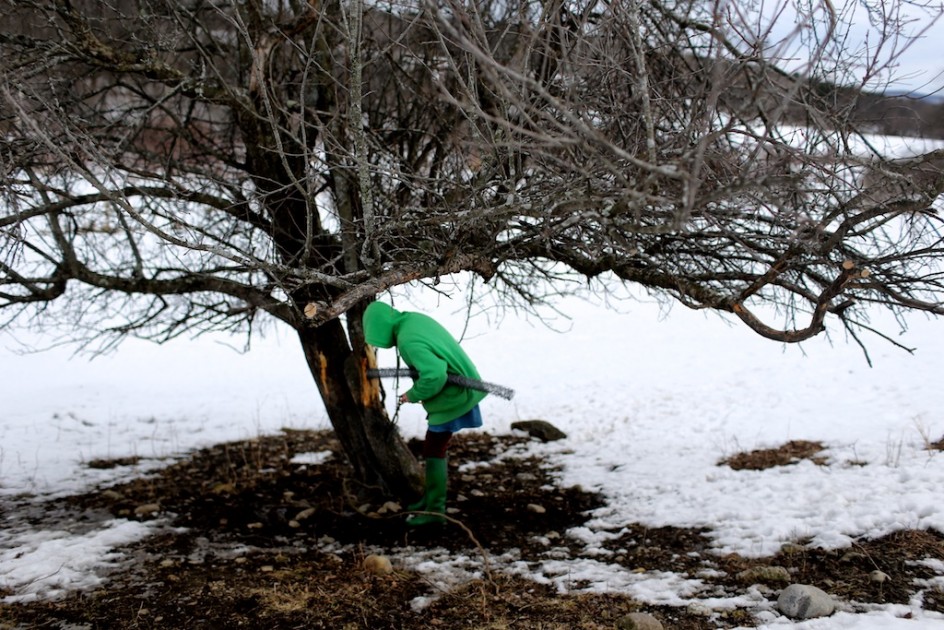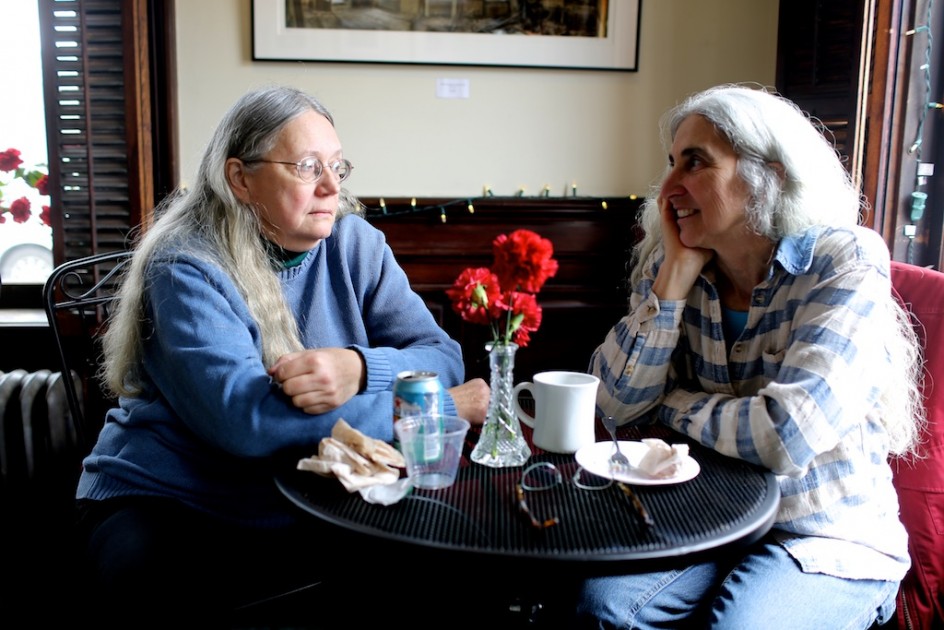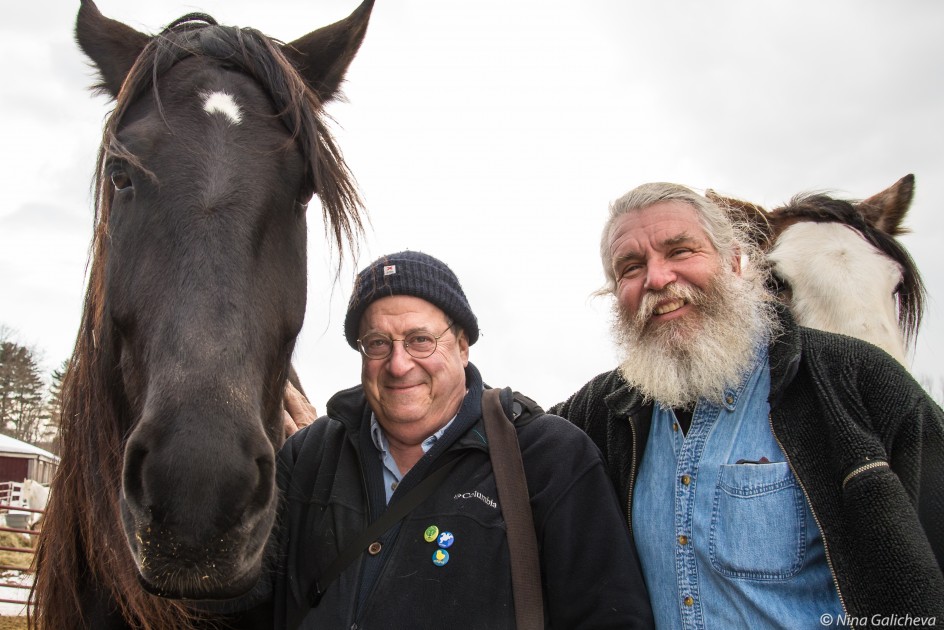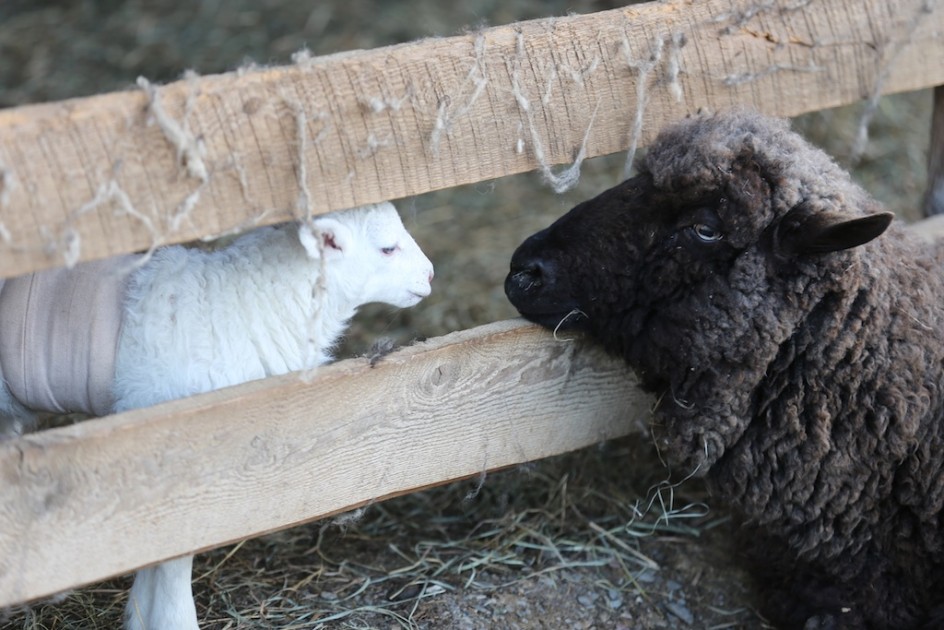
Working horses on the run, Blue-Star Equiculture, Palmer, Mass.

Working horses on the run, Blue-Star Equiculture, Palmer, Mass.

Farm chores are an organic part of farm life, you find one whenever you step outside. The donkeys are going slightly mad this winter, not grazing for two months, grazing is essential to their piece of mind and need for activity. They are working on eating the barn, we are running out of chicken wire trying to protect the wood. Sprays rarely work. We saw that they are working on one of the apple trees, one of my favorite photo subjects. We got out the chicken wire and pliers, we just have to hold then off for a few weeks. They are eating the gate to the pasture too. The barn looks like an army of locusts and termites struck.

I am drawn to photos of strong women, they face the camera without flinch or thought about how they look. Anne and Susan are good friends, old friends, strong women. I wanted to capture their time together sharing coffee at the Round House Cafe. I think the photo captures the comfort of strong friendship, the poise of strong women.

(This photo is by the very gifted New York City photographer and chronicler of the New York Carriage Horses Nina Galicheva).
I’ve been writing about the New York Carriage Horses for more than a year, but this photograph, taken at Blue-Star Equiculture Farm last Sunday by Nina Galicheva, tells me things are getting personal between me and the horses. That’s what people are telling me.
For most of the year, my writing about the horses has been conceptual, ideological. The campaign to drive them out of New York seems both ignorant and dishonest to me. It is unjust, that is what spurred me to write about it.
When Chief Avrol Looking Horses, the spiritual leader of the Sioux, told me the horses were speaking to me and praying for me to carry their messages, I was surprised, and confused. But now I know they are speaking to me, I no longer doubt it, it no longer is a strange idea for me. But what next? I’m not sure.
We had a pony on the farm – Rocky – but dogs, and to some extent, donkeys, sheep and barn cats have been the focal point of my life with animals, not horses. I try and live a life of the mind, but the horse question is becoming increasingly personal, I am drawn to these mystical creatures and I am being told they are drawn to me. Maria and I have become friends with Paul Moshimer (above) and Pamela Rickenbach,they are co-directors of Blue Star, the retirement and rescue farm for working horses and an organic farming center.
I have been drawn closer and closer to the horses, I feel they are speaking to me and through me, and in my visits to Blue-Star, I sense something deeper occurring, but I am not sure what. Pamela Richenback wrote this morning about my experiences at Blue- Star, she and Maria and others are seeing the impact the horses are having on me. The big horses are communicating with me in ways I can feel but not see, but which Maria and others can see very clearly.
I am one of those people who can see things in others, but not always in myself, a tunnel vision common to writers I think.
My remarkable journey began in a horse carriage stable in New York more than a year ago, it has led me to Blue-Star, an amazing experiment in Palmer, Mass. I believe Blue-Star and their values are the future for animal lovers and animals. There, they are showing us the way to keep animals in our world, to keep them with people, to treat them humanely and lovingly, to know them rather to see them as an ideological idea.
At Blue-Star, the pilgrims and prophets of the animal world – Native-Americans, poets, off-duty police officers and firemen, artists and photographs and animal lovers, students and the young, outcasts and misfits and warriors, animal lovers and writers – gather every day of the year, drawn to the farm like the wise men to Nazareth. It is an astonishing to see, especially against the backdrop of the anger, greed and argument that shrouds the lives of more and more animals and their people every day. The ponies need such a place, so do the elephants in the circus, and the working dogs, and the animals on farms.
So far, it’s only the horses, I believe that will change.
Pamela writes very personally about the horses, each one is an individual being to her and to Paul, they are not one thing, there is not one answer for all of them. They do not exploit animals for political purposes, or to feel good, they see them out and rescue them and look every day for ways to connect them to the work and people that will keep them safe and healthy. And engaged. There is a loving and nourishing feeling about the place, something I have never felt at an animal rights demonstration in New York City.
At Blue-Star, there are no arguments about horses, there is a common understanding about them, a common and healing and uplifting purpose. We need the horses, just as we need the dogs, we have always worked alongside of them, they need us. Domesticated animals like horses – and some elephants as well – must not be abandoned on preserves or driven to slaughterhouses. Their work needs to be protected, it is their salvation. The freedom and dignity of the people who own them also needs to be respected. These are the values at Blue-Star.
There, horses and animals are not a wedge to be driven against human beings, not a means of alienating people, attacking them or coming between them and the animals in their lives. The new idea in the great awakening is that we must support the people who live with animals and work with them and love them, not anger and frighten and harass them and seek to take their animals and livelihood away.
The animal world has, like the political world, become bitterly angry and polarized, but at Blue-Star I can see the way, the common purpose. It is the answer I have been looking form.
Blue-Star is the future. We don’t need to drive the animals away, or drive the people away who care for them. We can support both. We can make the lives of the animals better without pushing them out of the world. We can know them once again as the individual creatures that they are, as people used to know them. When animals lived amongst people, no one believed it was cruel for them to do their work. As we have moved farther and farther from them, this tragic idea that work is cruel and abusive has become endemic, and now threatens the very existence of every domesticated animal in the world.
We need a new and more humane and grounded understanding of animals. I see this at Blue-Star every time I visit there.
We used to know better, for almost all of our history. We used to know what was good for animals and what was not, we did not need disconnected ideologues to tell us. The people who made decisions about animals knew something about them. Every horse need not pull a carriage or haul lumber, each horse, like each human is different. The horses do not deserve to be lumped together and viewed as the same thing. As one learns right away at Blue-Star, their lives and needs ought to be determined by their nature, not by some angry political or ideological position. We owe it to them to do better.
Bella, the horse in the photograph above, was a fearful and mistreated animal when she came to Blue-Star, aggressive and anxious, impossible for most people to handle. She is calm and very different now, she shocked the people at Blue-Star when she came up to me and wanted to be part of our photograph. She had never approached a stranger before. What does this mean? Did she want to send a message, be part of the horse’s dramatic struggle to save themselves and remain in the great city? I don’t know, I can’t say. This is all a struggle for me.
Blue-Star is an important place, the most important place in the animal world that I have yet encountered.
If we can listen to them, they can show us the way out of the dysfunctional and divisive and self-serving morass that the animal rights movement has become. That movement does not save many animals, it doesn’t seem to know or understand animals or care for them much in the way they are cared for at Blue-Star. The contrast – you can see it for yourself – is stunning. You will never see an animal at an animal rights demonstration, you will never seen an animal rights activist touch a horse or bring one a carrot.
In New York, the horses simply become symbols, remote stand-ins for the rage and alienation of human beings in the modern world. All of them fit into one pocket, they are all abused and miserable animals needing rescue from hateful human beings to be happy and survive. At Blue-Star, it could hardly be more different. The animals are known and respected.
(You can help Blue-Star rescue horses, care for them, help heal Mother Earth. Check it out here.)
The people at Blue-Star speak for the true animal lovers in the world, these are people who love animals and care about their true rights. The more we understand the horses, the more certain we are that they belong with us. At Blue-Star, everyone gets to know the animals there, see them as distinct entities from one another, then come to a true realization of what they need, of what is best for them.
For me, this journey is just beginning, and I do see that the horses have called me to it. I am open to learning what it is that is really happening to me, and I see that the answer for me can perhaps be found at Blue-Star, already a historic place in the history of the human-animal bond.
I’ve been wondering for years how the animals of the world can be saved from the political quagmire that engulfs them and threatens them and obscures the most crucial issue facing them – how can they survive among us when our culture seems intent on driving them away? More than anything, Pamela and Paul’s vision is to find way that animals and people can work together, and both be treated with love and respect.
That is the new and wiser understanding of animals that the author and naturalist Henry Beston called for a century ago, that is the vision that the animal rights movement has failed to see or find. That is the humane vision, the truly progressive one, the way to protect their genuine rights and welfare.
That is the vision that every true animal lover can accept and adopt. It is a powerful wave, I believe it is coming. The horses remind us that we are at a crossroads, the world is bleeding, every one of us has to decide whether we will work to save the natural world or abandon it to cowardly and greedy politicians and ideologues exploiting animals rather than saving them.

I’m heading to Bucks County, Pa. Saturday morning to pursue two things of great meaning to me, my book “Saving Simon,” and a good cause, therapy and working dogs. Therapy dogs are perhaps the most powerful argument for keeping working animals in our lives, they work miracles every day. My friend Deborah Glessner has invited me to speak for the benefit of her dog therapy group “Nor-Wester Readers,” a canine-assisted reading program for children.
I’m giving a talk about “What Animals Mean To Us” at 2 p.m. Sunday and then, Sunday night, having dinner (it is sold out) with some people who paid money to eat with me, an interesting concept for me. I am always stunned when people in places like South Dakota tell me how much the blog means to them, and also surprised that people would pay to have dinner with me, although it does benefit the therapy dog program. That makes sense.
There are still a few tickets left for the talk, Deborah tells me, though not many.
I’m also resuming the “Saving Simon: How A Rescue Donkey Taught Me The Meaning Of Compassion,” book tour. Going to Connecticut next weekend, then to Massachusetts. Iowa in May.
I’ve been to three or four dinners in my writing life where people paid to have supper with me, they were all very different. At the first dinner, held at a gorgeous farm in upstate New York, five or six people paid hundreds of dinners so sit with me at a dinner table. None of them spoke to me, asked me a question or talked to me at all, they seemed to be talking to one another about their dogs, cats and other animals, or their investment portfolios.
The host was embarrassed (the food was great) and I was sorely tempted to ask them why they had come at all, but we never did figure it out. At the second dinner, a huge fight broke out between the dinner guests over how to get a dog and how to train one, and then over politics, a “left-right” thing . The fight had nothing to do with me, I hadn’t said a word, and the host had to separate the warring factions. She did raised $1,000 for her charity, I forget what it was.
The third dinner was sweet, nice and interesting people, we talked for hours about animals and what they mean to us, I got some wonderful questions. When it works, it’s a wonderful forum for an author, a way to talk about writing, to get close to readers and the people I write about.
Still, I can hardly wait to see what happens Sunday in Bucks County, maybe there will be a food fight. They might not like my ideas about the carriage horses or the elephants. Disagreement is good, it does not bother me. I have lots to talk about, at the talk and the dinner – my life with animals, the carriages horses, the elephants, animal grieving, the future of animals in our world, the reasons animals have become such a central part of our emotional lives.
And it will be good to see Deborah, she is a wonderful photographer and passionate animal lover. She is a member of the Creative Group At Bedlam Farm, we are a close-knit group, we always help each other out.
She’s been scheming to get me to Bucks County for some years now, I am happy we are finally doing it. Red is staying home with his pal Deb Foster, I love Red but I never love hauling a dog around strange places, there is no need for it, and he will be in good company. Separation is healthy for dogs and people, I believe, I am not one of those who wants to take the dog on vacation. I love sleeping late, especially when Maria is in bed also. She is coming with me.
I will be back Monday morning. I remember Bucks County from my reporting days as being gorgeous and interesting, filled with artists and artistic history – the Wyeths are based there. If we get there early enough, I imagine we will hit a museum.